
|
Sale 80
June Pre Long Beach Sale
| Lot |
Photo |
Description |
Realized |
Lot 235 |
 |
1913. Type 1. PCGS graded MS-67 PQ. CAC Approved. Housed in an Old Green Holder. Boldly struck with superb wonderful blue toning. The surfaces immaculate and untouched. Pop 470; 27 finer, 14 in 67+, 13 in 68 (PCGS # 3915) .
Estimated Value $500-UP.
View details and enlarged photos
Check results on similar lots
| Realized
$793 |
Lot 236 |
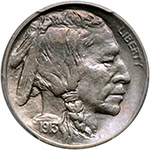 |
1913. Type 1. PCGS graded MS-65. PQ. Lovely rich lilac toning. Well struck, a Gem quality example, and the first design. James Earle Fraser had the hubs and master dies for the 1913 Type 1 Nickel made at the Medallic Art Company in New York and submitted them to the Mint, rather than trust the task to the always petulant Mint's Chief Engraver, Charles E. Barber. Fraser had made numerous studies of Native Americans before undertaking the task of creating an Indian head for the nickel. The obverse portrays a mature warrior facing right. His hair is braided in the style of the plains Indians with a ribbon securing the braid. Two feathers are affixed near the part of the hair, and a third one is only partly visible. The garment across his shoulder provides a foundation for the coin�s date, and Fraser�s initial letter �F� appears below the date. On both the original model and the struck coin, the subject appears to be in a contemplative state with eyes half closed. (For a detailed account of this fascinating coin, see David W. Lange�s The Complete Guide to Buffalo Nickels (PCGS # 3915) .
Estimated Value $130 - 140.
View details and enlarged photos
Check results on similar lots
| Realized
$112 |
Lot 237 |
 |
1913. Type 2. PCGS graded MS-66 PQ. Housed in an Old Green Holder. A nice well struck coin. Nice, clear-cut strike for the every part of the design, unlike some where one finds a modicum of weakness at the buffalo. A desirable Gem. Pop 197; 27 finer, 7 in 66, 19 in 67, 1 in 67+ (PCGS # 3921) .
Estimated Value $700 - 750.
View details and enlarged photos
Check results on similar lots
| Realized
$852 |
Lot 238 |
 |
1913-S. Type 2 PCGS graded Genuine Good Details. Environmental damage. Clear date and mint mark on this scarcer first-year branch mint issue by the San Francisco Mint (PCGS # 3923) .
Estimated Value $110 - 120.
View details and enlarged photos
Check results on similar lots
| Realized
$141 |
Lot 239 |
 |
1914-S. NGC graded MS-64. The devices, particularly the buffalo, were struck with such power by the dies that all design elements show boldly. An impressive '14-S nickel. Pop 384; 86 finer .
Estimated Value $375 - 400.
View details and enlarged photos
| Realized
$423 |
Lot 240 |
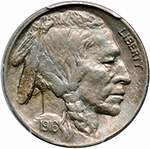 |
1916. Doubled Die Obverse. PCGS graded AU-55 PQ. CAC Approved. Nice bold strike with light even toning. Looks Mint State. Because all dies of this design were completely hubbed except for mintmarks, varieties come from hubbing accidents or mintmark repunching or overpunching, with one outstanding exception (the 1937-D 3-leg). Hubbing accidents produced such extraordinary anomalies as the 1916 doubled die (from the same process that produced the similarly famous 1955 doubled die cents). Minor doubling, often at the Indian�s profile or date, exist for many dates, but only this famous 1916 has such a major doubling; others have mostly remained overlooked and without the popularity.
A Heritage sale from 2009 of a Mint State 64 1916 Doubled Die, provides the best description of the doubling that we have read: "In the case of the 1916 Doubled Die Obverse nickel, that pivot point is somewhere between 1 and 2 o'clock on the obverse, within the letters of LIBERTY. As a consequence, that word shows no doubling to the unaided eye, being too close to the pivot to show anything but a microscopic spread. Moving away from that particular area, however, doubling is widespread across the rest of the devices, from a small shift visible at the Indian's brow and lips (most examples show doubling below the nose as well, though this piece does not, likely due to die polishing), to more dramatic doubling on the feathers and braid. The most dramatic doubling of all appears directly across from the pivot point; happily for this variety, that area contains the digits of the date and the lower hair ribbons, both of which exhibit the characteristically bold doubling that has attracted collectors since the variety became widely publicized in the mid- to late 1970s. Wexler et al. note that the 1916 Doubled Die Obverse variety �… actually has a wider spread on the date than the 1955 Lincoln cent doubled die obverse.�"
Engraver Charles Barber modified the design in 1916. Coins of 1916-38 could almost be called as "Type III": LIBERTY is from this time forth much sharper, the Indian's nose longer, and many other details have again been changed after the major improvement in 1913 with the Type 2. Yet this failed to help striking quality; resistance to circulation wear was still worse, the dates becoming quickly illegible. (Some mintmarked nickels 1918-35 are virtually unknown well struck.) The 1916 Doubled Die Obverse is one of two key coins in the series. Uncirculated survivors are all but unobtainable without a loan on your vacation castle in the Swiss Alps! An About Uncirculated, however, is just the ticket for a high-end Buffalo Nickel set. This remarkable coin has enough mint luster so that nobody will argue with the conservative grade. Pop 21; 10 finer, 4 in 58, 2 in 62, 1 in 63, 3 in 64 (PCGS # 3931) .
Estimated Value $30,000-UP.
View details and enlarged photos
Check results on similar lots
| Realized
$36,425 |
Lot 241 |
 |
1918-S Sharpness of AU. Lamination on the obverse.
Estimated Value $600 - 650.
View details and enlarged photos
| Realized
$353 |
Lot 242 |
 |
1918-D. PCGS graded MS-66 PQ. A nice fully struck example. The original mintage for this date was 8.3 million pieces, and in the years since coinage, the 1918-D has been found to be a scarcer year when well struck, although definitely not one of the rarest issues in this series. It is, however, scarce in all grades at or above VF, and the 1918-D is particularly rare at the finer Mint State levels when found with a sharply executed strike like the present jaw-dropping MS66 example in this Lot. With snappy-looking definition in all areas, this important coin has bright nickel-gray to silvery metal flow that enhances the glittering mint bloom on the surfaces, giving the coin a shimmering, almost a magical glow to its appearance. The original mint brilliance is only interrupted by an occasional speck of pale golden color. Concerning the strike, there are no areas of vexing incompleteness of detail on either side. A fully lustrous, originally preserved example for the collector who esteems high-grade Buffalo Nickels. Pop 22; 3 finer, 2 in 66+, 1 in 67 (PCGS # 3938) .
Estimated Value $6,000 - 6,500.
View details and enlarged photos
Check results on similar lots
| Realized
$6,609 |
Lot 243 |
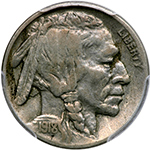 |
1918-D, 8 over 7. PCGS graded VF-20 PQ. CAC Approved. Very popular variety. Missing from most collections. Lightly toned and choice. The 1918/7-D overdate without doubt matches the famous 1916/1916 and 1937-D 3-leg nickels for the title of most popular and highly sought variety in the series. Though discovered as long ago as 1931, it remains scarce to this day.
The obverse die for this variety was made during the latter part of 1917 at the Philadelphia Mint. It is during the final quarter of each year that the Mint�s engraving department begins to make dies for the next year�s production. As described in David W. Lange�s book on the Buffalo Nickel series, "a nationwide shortage of minor coins (cents and nickels) developed during 1917-18 and led to an unprecedented output of these. It is therefore easy to understand that dies for both 1917 and 1918 would have been in preparation during the latter months of 1917 to meet both current and anticipated needs.
"In sinking a working die, two or more impressions had to be taken from a working hub. Between each impression, the developing die was taken to the furnace to be annealed, or softened, since the first impression caused the metal to become work-hardened. It was then ready for another impression. Amid the haste to produce new dies, a working die that had already been impressed with a hub dated 1917 was then either inadvertently or intentionally given another impression from a hub dated 1918. The result was an overdate." (PCGS # 3939) .
Estimated Value $3,800 - 4,000.
View details and enlarged photos
Check results on similar lots
| Realized
$4,583 |
Lot 244 |
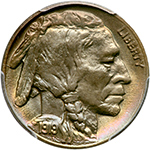 |
1919-D. PCGS graded MS-66 PQ. Wonderful rainbow toning on both sides. The close of World War I saw a drastic need for Nickel production at both the Denver and San Francisco Mints in 1919. When it came to the former facility, the total number of Denver Mint coins delivered that year amounted to a little over 8 million pieces. This limited mintage figure, when coupled with extensive circulation, explains why the 1919-D is rare in all but the lowest grades. Comparatively more important, however, is the fact the '19-D is also one of the most challenging Buffalo Nickels to locate with any degree of striking detail. Miserable strikes abound. Sharp ones are almost unheard of. Our offering of this wonderful Gem Mint State 66 specimen -- and Premium Quality no less! -- represents an opportunity of profound importance, something for collectors who specialize in this series.
The strike is almost certainly the fullest that one can realistically encounter on a 1919-D Nickel. All design elements are nicely delineated, and there are no areas of bothersome incompleteness of detail on either side. The surfaces are fully lustrous and satiny beneath a delicate overlay of golden iridescence. There are no distracting abrasions to report, and wonderful color A beautiful coin in all regards, and one that is seemingly destined for inclusion in another Buffalo Nickel Registry Set. Pop 18; none finer at PCGS. Tied for the finest at PCGS (PCGS # 3942) .
Estimated Value $9,000 - 10,000.
View details and enlarged photos
Check results on similar lots
| Realized
$10,869 |
Lot 245 |
 |
1920. PCGS graded MS-63. Some flyspecks, but easily ignored when viewing the smooth, consistently choice and glowing luster (PCGS # 3944) .
Estimated Value $100 - 110.
View details and enlarged photos
Check results on similar lots
| Realized
$118 |
Lot 246 |
 |
1920-S. NGC graded MS-66. Lovely rainbow toning on both sides. Well struck. Pop 3; none finer at NGC .
Estimated Value $35,000 - 40,000.
View details and enlarged photos
| Realized
$43,475 |
Lot 247 |
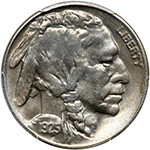 |
1925-S. PCGS graded MS-65. Lovely light even toning. A gorgeous example. This high-end Gem shows an exactness of strike and high quality to which most 1925-S Nickels can only aspire. The overall definition is nearly as close to full as one could realistically expect in an example of this S-mint strike rarity. Even the bison's head and shoulder on the reverse are show much (if not complete) detail.
Moving on to the surface preservation, we find that both sides have retained their full endowment of satiny mint luster. They have acquired a thin veil of color, but remain virtually free of grade-limiting blemishes. A beautiful Gem S-mint coin in all regards, and one that is tied for Condition Census #1 among survivors of this very challenging S-mint Buffalo Nickel delivery. Pop 27; 1 finer in 66 (PCGS # 3956) .
Estimated Value $18,000 - 19,000.
View details and enlarged photos
Check results on similar lots
| Realized
$21,150 |
Lot 248 |
 |
1926-S. PCGS graded MS-64+. CAC Approved. Well struck with nice light toning. A popular key date. Dates ranging from 1919-D, 1919-S, 1920-S, 1925-D, 1925-S, and (possibly) 1926-D tend to be miserably struck. Some give top honors to the 1926-S as the worst struck issue in the entire Buffalo Nickel series. Ironically, the few known Mint States are recognized for their sterling luster quality and suitable planchet stock, but the vast majority of survivors are overall flat on the reverse from having been struck from extensively worn dies. A slim original mintage of 970,000 pieces adds to the pain of locating a suitable high-grade '26-S Nickel. Today�s market is particularly tight on these.
This solidly graded MS64+ is in the zone where advanced specialists congregate. The otherwise pale golden-gray surfaces reveal delicate wisps of a sheen of iridescence as the viewer tips it up and down under a strong light. Satiny in sheen, it is, with both sides almost silent on the subject of any blemishes. Clearly there are no spots. Now for the most important feature: the strike: very sharp for the issue with full definition in the center of the obverse and throughout the bison's head and horn, shoulder, and tail on the reverse. The horn is fully formed (unusual to say the least). One of the most desirable '26-S Nickels that we have offered in this grade in recent memory, this virtual Gem is certain to see determined bidder action when auctioned. Pop 4; 14 finer in 65 (PCGS # 3959) .
Estimated Value $15,000 - 16,000.
View details and enlarged photos
Check results on similar lots
| Realized
$17,625 |
Lot 249 |
 |
1927. NGC graded MS-67. Well struck with nice light golden toning. Pop 10; 1 finer in 67 Star .
Estimated Value $4,500 - 5,000.
View details and enlarged photos
| Realized
$5,405 |
Lot 250 |
 |
1927-D. NGC graded MS-66. Lovely rainbow toning. Well struck. Pop 7; none finer at NGC .
Estimated Value $15,000 - 16,000.
View details and enlarged photos
| Realized
$15,863 |
Lot 251 |
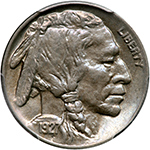 |
1927-S. PCGS graded MS-65. CAC Approved. Well struck for this date. Nice even toning on both sides. Writing in 2000, David W. Lange states in his book on the series: "[The] 1927-S is generally well struck for an S-mint Nickel of the 1920s…" Based on this comment, we believe that widespread circulation is more to blame for the high-grade shortage of the '27-S than is poor striking quality. Since the PCGS Population of this issue tails off sharply above the Mint State 64 level, we anticipate considerable competition for this lightly toned Gem among Registry Set collectors. Both sides exhibit dominant sandy-gold toning with intermingled sleek luster radiance and nickel-smooth iridescence. The strike is overall sharp and free of criticism; moreover, there are no noteworthy distractions. Specialists who appreciate originality, who are drawn to exceptional quality would be shrewd to enter strong bids for this impressive '27-S Nickel. Pop 24; 1 finer in 66 (PCGS # 3962) .
Estimated Value $11,000 - 12,000.
View details and enlarged photos
Check results on similar lots
| Realized
$15,275 |
Lot 252 |
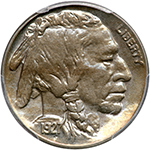 |
1927-S. PCGS graded MS-65 PQ. Lovely blue and golden toning. Nice luster. A very attractive coin. Pop 25; 1 finer in 66 (PCGS # 3962) .
Estimated Value $10,000 - 11,000.
View details and enlarged photos
Check results on similar lots
| Realized
$11,750 |
Lot 253 |
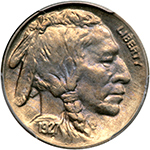 |
1927-S. PCGS graded MS-64. CAC Approved. Nice golden toning. Highly desirable in Mint State, and more than ever in choice MS64 condition; finer specimens of the date have been graded by PCGS but are multiples of the price of this still very attractive coin. Indeed, of the more than 3.4 million pieces struck, a fair number but not really a large population have been graded this high. Pop 253; 27 finer, 1 in 64+, 25 in 65, 1 in 66 (PCGS # 3962) .
Estimated Value $2,100 - 2,200.
View details and enlarged photos
Check results on similar lots
| Realized
$2,761 |
Lot 254 |
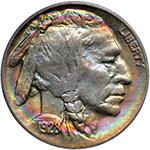 |
1928-D. PCGS graded MS-62. Lovely rainbow toning on the obverse (PCGS # 3964) .
Estimated Value $100 - 125.
View details and enlarged photos
Check results on similar lots
| Realized
$282 |
Lot 255 |
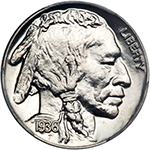 |
1936. Type 1. PCGS graded Proof 68. Well struck and brilliant. Only 4,420 minted. A satiny gem with richly imbued luster that graces the frosty nickel-bright sheen of the surfaces. 100% boldly struck for the date, indeed, about as fine a Proof as is ever found. James Earle Fraser would have loved this one! Type 1 survivors are a bit rarer than those of their identically dated Type 2 counterpart because the satin-finish specimens did not ring a favorable chord among contemporary collectors who remembered the bright, mirror-finish Barber coinages of their parents� day. This is certainly one of the most exceptional Proof 1936 Type 1 Nickels extant. Pop 32; 1 finer in 69 (PCGS # 3994) .
Estimated Value $8,500 - 9,000.
View details and enlarged photos
Check results on similar lots
| Realized
$9,694 |
Lot 256 |
 |
1936. Type 1 Satin. NGC graded Proof 68. Only 4,420 minted. Nice light even toning and boldly struck. Pop 26; 2 finer in 68 Star (PCGS # 3994) .
Estimated Value $5,500 - 6,000.
View details and enlarged photos
Check results on similar lots
| Realized
$5,875 |
Lot 257 |
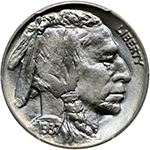 |
1937. PCGS graded MS-68. Mostly untoned with a hint of light tone. A wonderful coin. Tied for Finest. It appears that even the artist who designed this piece, James Earle Fraser, preferred the familiar term "buffalo" to the more zoologically correct bison. Semantics aside, the model for the nickel�s reverse is known to have been a bull named Black Diamond. This animal was then a resident of New York City�s Central Park Zoo and was already about seventeen years old at the time. Fraser�s own correspondence reveals his exasperation in attempting to keep this beast posed in profile as depicted on the coin. Evidently quite uncooperative, it insisted on confronting the artist head on and would return to this stance immediately after being corrected.
Black Diamond has occasionally been cited as the model for the $10 United States Note of 1901, the so-called "buffalo bill." This attribution is incorrect, as the greenback actually portrays Pablo, a star attraction at the National Zoo in Washington, D.C. This mistaken identity is understandable, as the $10 note was in use alongside the nickel through the late 1920s. (For a detailed account of this fascinating coin, see David W. Lange�s The Complete Guide to Buffalo Nickels.) Pop 6; none finer at PCGS (PCGS # 3980) .
Estimated Value $15,000-UP.
View details and enlarged photos
Check results on similar lots
| Realized
$18,213 |
Lot 258 |
 |
1937. PCGS graded Proof 68. Superb and fully brilliant without any toning. Only 5,769 minted. The reverse of Fraser's five-cent piece is memorable in its profile view of a bison bull. In recalling this particular work, James Earle Fraser spoke of its unique character: "My first objective was to produce a coin which was truly American, and that could not be confused with the currency of any other country. I made sure, therefore, to use none of the attributes that other nations had used in the past. And, in my search for symbols, I found no motif within the boundaries of the United States so distinctive as the American buffalo." Pop 17; 1 finer in 69 (PCGS # 3996) .
Estimated Value $10,000 - 11,000.
View details and enlarged photos
Check results on similar lots
| Realized
$15,275 |
Lot 259 |
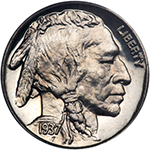 |
1937. PCGS graded Proof 66 Cameo. PQ. A gleaming Superb Gem Brilliant Proof coin that has light cameo frost on the devices. Only 5,769 struck. When the sale of Proofs resumed in 1936 the brilliant style was restored, but without the frosted relief that had made earlier Proofs (Liberty and Shield nickels) so stunning. The textured fields evident in Fraser�s original models and in the Type 1 coinage of 1913 had been smoothed out by Charles Barber that same year when he prepared the Type 2 reverse. This made both obverse and reverse receptive to high polishing, though such polishing also led to certain low-relief features of the dies being easily obliterated. Nevertheless, collectors were more enthusiastic about the end product than they were with the earlier "matte" Proofs of 1913-16. However, almost as soon as Proof coinage resumed, the buffalo nickel was discontinued in favor of the new Jefferson type. This left only the issues of 1936 and 1937 available to collectors desiring brilliant Proofs of this beautiful design. Pop 5; 6 finer, 5 in 67, 1 in 67+. (PCGS # 83996) .
Estimated Value $6,000 - 6,500.
View details and enlarged photos
Check results on similar lots
| Unsold |
Lot 260 |
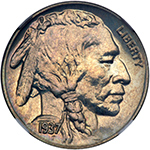 |
1937. NGC graded Proof 67. CAC Approved. Lovely rich golden toning. Only 5,769 struck. The nickel-bright color is especially vivid on this handsome late-period Buffalo Nickel. Earlier pieces that were struck in the 1910s, were given a sandblast finish. But by the 1930s, the mint had developed the mirror technique and began offering brilliant mirror finish Proofs to the public starting in 1936. All were carefully made and in very limited numbers compared to today�s Proof totals. In such circumstances, the luster cannot stand alone. Desirable also is to see that this coin is struck with meticulous care by the dies. Pop 322; 68 finer at NGC.
Estimated Value $2,200 - 2,300.
View details and enlarged photos
| Unsold |
Lot 261 |
 |
1937-D. 3 Legs. PCGS graded MS-64 PQ. CAC Approved. A hint of light gold tone on both sides. Very close to MS-65. A die-polishing error, this was the first of its kind to catch the attention of collectors. Discovered soon after its release into circulation, 1937-D 3-leg nickels were advertised for sale in an advertisement in "The Numismatic Scrapbook Magazine" as early as 1937-38. The variety was caused by undue polishing of the dies to eliminate clash marks. Die clash arises when the feeder fingers of a coin press fail to deliver a planchet, the dies strike one another, and each die picks up an imprint of the other die. This mark, when discovered, usually results in the substitution of both dies with new ones. In the case of the 1937-D 3-leg nickel, however, the pressure to complete a coinage run must have detoured this customary practice. The swifter solution was sought. Very few Choice Uncirculated MS64 examples are known, coin collectors being equally scarce in that part of the country, it seems, when they first got paid out by bank tellers. (For a more detailed account of this popular variety, see David W. Lange's The Complete Guide to Buffalo Nickels.) Pop 169; 64 finer, 3 in 64+, 52 in 65, 3 in 65+, 6 in 66 (PCGS # 3982) .
Estimated Value $7,000 - 7,500.
View details and enlarged photos
Check results on similar lots
| Realized
$8,225 |
Lot 262 |
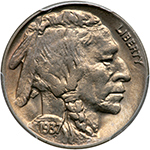 |
1937-D. 3 Legs. PCGS graded MS-64 PQ. Lovely golden toning. A very commendable Mint State 64 of steadfast quality, being frosty, lustrous, and pretty much free of marks. A satiny beauty, a landmark example of the issue. Regarding the issue, it is arguably America's most talked-about "error" coin unless one wants to argue minutia and say that the 1955 Doubled Die Cent edges it out. The date (along with other famous rarities, including the 1943 "copper" cent and the 1804 dollar) was advertised extensively in the 1950s and 1960s in kids� comic books. Just as the quality of the piece is steadfast, then too must bidders at bidding time hold steadfast against competitors or forever miss this opportunity. Pop 169; 64 finer, 3 in 64+, 52 in 65, 3 in 65+, 6 in 66 (PCGS # 3982) .
Estimated Value $6,000 - 6,500.
View details and enlarged photos
Check results on similar lots
| Realized
$7,638 |
Lot 263 |
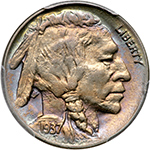 |
1937-D. 3 Legs. PCGS graded MS-63. Lovely multicolor toning on both sides, pastel pink, rose, blue and gold. This coin features unbelievably beautiful and shimmering iridescent colors, with the absence of spots or discoloration improving the appearance all the more! Struck with almost scientific exactness throughout the main devices, understanding the proviso that the reverse die had been injured when the two dies clashed. The reverse die was removed from the minting press, a technician ground away the clash evidence, and returned it to the equipment for continued operation, never realizing that the buffalo was now missing its lower front leg! Only the hoof is there. A famous rarity. A coin of distinction in this choice Mint quality and with spectacular color (PCGS # 3982) .
Estimated Value $4,000 - 4,250.
View details and enlarged photos
Check results on similar lots
| Realized
$5,288 |
Lot 264 |
 |
1937-D. 3 legs. PCGS graded AU-55. PQ. Lovely toning on both sides. Housed in an Old Green Holder. This die-polishing variety was the first of its kind to capture the imagination of collectors. Discovered soon after its issue, 1937-D 3-leg nickels were advertised for sale in an ad in The Numismatic Scrapbook Magazine as early as 1937-38. The variety was caused by excessive polishing of the dies to remove clash marks. Die clash occurs when the feeder mechanism of a coin press fails to deliver a planchet, the dies strike one another, and each receives an impression of the opposing die. This disfigurement, when discovered, usually results in the replacement of both dies. In the case of the 1937-D 3-leg nickel, however, the urgency of completing a coinage run precluded this customary practice, and a swifter solution was sought. Very few Choice AU examples and higher are known, coin collectors being equally scarce in that part of the country, it seems, the error wasn't immediately recognized. (For a more detailed account of this popular variety, see David W. Lange�s The Complete Guide to Buffalo Nickels.) (PCGS # 3982) .
Estimated Value $900 - 1,000.
View details and enlarged photos
Check results on similar lots
| Realized
$1,586 |
Lot 265 |
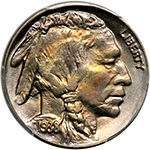 |
1938-D. PCGS graded MS-65. Lovely rainbow toning on the obverse (PCGS # 3984) .
Estimated Value $100 - 110.
View details and enlarged photos
Check results on similar lots
| Realized
$65 |
Lot 266 |
|
A lot of Buffalo Nickels. Consists a total face value of about $29.00. This lot includes some dateless coins, but also has some slightly better dates. Coins will grade AG to UNC. Careful study recommended.
Estimated Value $150-UP.
Donald J Mack Collection.
View details
| Realized
$247 |
|
|